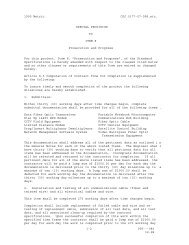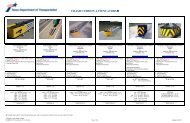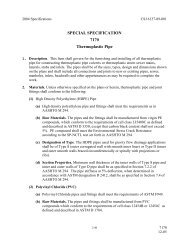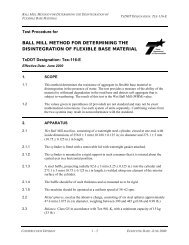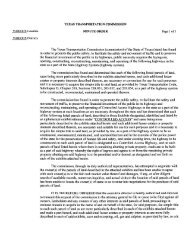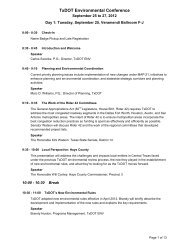Calcium Aluminate Cement Concrete (Class CAC Concrete) TxDOT ...
Calcium Aluminate Cement Concrete (Class CAC Concrete) TxDOT ...
Calcium Aluminate Cement Concrete (Class CAC Concrete) TxDOT ...
Create successful ePaper yourself
Turn your PDF publications into a flip-book with our unique Google optimized e-Paper software.
➨ WHAT IS CALCIUM ALUMINATE CEMENT<br />
(<strong>CAC</strong>) AND HOW DOES IT DIFFER FROM<br />
ORDINARY PORTLAND CEMENT (OPC)?<br />
<strong>Calcium</strong> aluminate cement (<strong>CAC</strong>) is a unique class of cement<br />
that is different than ordinary Portland cement (OPC),<br />
particularly due to the chemical make-up. <strong>CAC</strong> contains a far<br />
greater amount of alumina and a far less amount of silica. Table<br />
1 illustrates the major chemical compositions of OPC and <strong>CAC</strong>.<br />
Table 1. Chemical Properties of OPC and <strong>CAC</strong><br />
(<strong>Cement</strong> chemistry notation is used C=CaO, S=SiO 2, A=Al 2O 3, and F=Fe 2O 3.)<br />
Silicates<br />
T E X A S D E P A R T M E N T O F T R A N S P O R T A T I O N<br />
Published as needed by the Construction and Bridge Divisions - August 2010<br />
<strong>Calcium</strong> <strong>Aluminate</strong> <strong>Cement</strong> <strong>Concrete</strong> (<strong>Class</strong> <strong>CAC</strong> <strong>Concrete</strong>)<br />
<strong>TxDOT</strong> Special Specification SS-4491 Tip Sheet<br />
by Ryan Barborak, P.E., CST-M&P<br />
Phase<br />
Ordinary<br />
Portland<br />
<strong>Cement</strong><br />
(%)<br />
<strong>Calcium</strong><br />
<strong>Aluminate</strong><br />
<strong>Cement</strong><br />
(%)<br />
C 3S 50-70 0<br />
C 2S 15-30
Technical Advisory <strong>Class</strong> <strong>CAC</strong> <strong>Concrete</strong> SS-4491 Tip Sheet<br />
Table 3. <strong>CAC</strong> Compressive Strength of Mix Design Similar to<br />
SS-4491 [Ambient Temperature = 44°F]<br />
Age (hrs.) Compressive Strength (psi)<br />
2.00 840<br />
2.25 1273<br />
2.50 2314<br />
2.75 2895<br />
3.00 3668<br />
3.25 3875<br />
3.50 4216<br />
3.75 4402<br />
4.00 4629<br />
Source: Tested by S.T.A.T.E. Testing L.L.C. “Compressive Strength Results of<br />
GCX/PP-5 Yard Trial.” November 24, 2009. Chicago, IL. unpublished.<br />
Literature suggests that in practice, as long as the concrete<br />
remains above freezing until the hydration begins (usually<br />
about 3 hours), the heat generated by <strong>CAC</strong> will be sufficient<br />
to ensure rapid hardening, even if the aggregates are below<br />
the freezing point. Canada has extensively used this material<br />
to build foundations in frozen ground. 3 Consultation with<br />
the producer and trial batches at the ambient<br />
temperature is recommended for the low<br />
temperature (
Technical Advisory <strong>Class</strong> <strong>CAC</strong> <strong>Concrete</strong> SS-4491 Tip Sheet<br />
box. This type of curing is often referred to as adiabatic<br />
curing. The well insulated box allows the cylinders to gain<br />
considerable heat as the heat generated by hydration is not<br />
easily dissipated. Figure 1 shows a heat-time graph of<br />
specimens cured inside (adiabatic) and outside (ambient) of<br />
the curing box.<br />
Temperature (F)<br />
Figure 1. Graph of Heat Generated by <strong>CAC</strong><br />
The results in Figure 1 demonstrate how much more heat gain<br />
(upwards of 63°F in this particular trial) is achieved by placing<br />
a large size specimen in a well insulated environment as<br />
opposed to a small specimen placed outside in ambient<br />
conditions (~60°F). This high hydration temperature causes<br />
the <strong>CAC</strong> to convert within 24 hours, thereby giving an<br />
estimation of the converted strength. Figure 2 shows the<br />
corresponding strength results of the same set of specimens<br />
subjected to the temperatures given in Figure 1.<br />
Compressive Strength (psi)<br />
200<br />
180<br />
160<br />
140<br />
120<br />
100<br />
80<br />
60<br />
40<br />
20<br />
0<br />
3/19/09<br />
12:00 AM<br />
Figure 2. Compressive Strength Data of Ambient and<br />
Adiabatic Curing<br />
10000<br />
9000<br />
8000<br />
7000<br />
6000<br />
5000<br />
4000<br />
3000<br />
2000<br />
1000<br />
0<br />
3/19/09<br />
12:00 PM<br />
3/20/09<br />
12:00 AM<br />
3/20/09<br />
12:00 PM<br />
Time and Date<br />
3/21/09<br />
12:00 AM<br />
Ambient 4x8 Adiabatic 6x12<br />
Curing Type<br />
Adiabatic 6x12<br />
Ambient 4x8<br />
1-Day<br />
2-Day<br />
3<br />
From the results illustrated in Figure 2, the converted strength<br />
estimated is approximately 6,000 psi. That is, sometime<br />
during the life of the structure, the minimum compressive<br />
strength should be approximately 6,000 psi, although it may<br />
initially be as high as 9,000 psi or more. Hence the percent<br />
reduction in strength is expected to be on the order of 33%<br />
and the converted compressive strength of 6,000 psi needs to<br />
be used for the design strength.<br />
It is important to note that the traditional maturity<br />
method that is used to quantify the compressive<br />
strength of OPC concrete (e.g., Tex-426-A), cannot<br />
be utilized for <strong>CAC</strong> concrete due to the conversion<br />
behavior.<br />
➨ WHAT ARE THE LIMITATIONS OF<br />
ADIABATIC CURING?<br />
Adiabatic curing is extremely effective when the<br />
initial concrete temperature is above 60ºF. When<br />
the initial concrete temperature falls below 40°F,<br />
the heat generated by the hydration is not enough<br />
to exceed the 140°F temperature necessary for<br />
conversion to fully take place within the first 24<br />
hours. This is the reason why the temperature of the<br />
specimens must be recorded during the first 24 hours. If the<br />
temperature does not exceed 140°F inside the<br />
adiabatic box, it is recommended that the 7-day<br />
compressive strength specimens outlined in <strong>TxDOT</strong><br />
SS-4491 be twice than what the design strength is<br />
required. This will ensure that the converted strength due to<br />
conversion will be greater than the design strength. This being<br />
the case, it is critical that the 7-day specimens be cured as<br />
described in ASTM C 31, paying special attention to the<br />
temperature range of 60°F to 80°F, as this will affect the 7-day<br />
strength. Keep in mind this is not only important in the winter<br />
months but is also equally important in the summer months. If<br />
the 7-day specimens are exposed to higher temperature, for<br />
instance kept at the job site during the first day at 100ºF, the<br />
7-day strength may be reduced since the conversion process<br />
may be initiated. Thus, the prediction using 50% of this value<br />
will be lowered, too.<br />
Good record keeping is also recommended for<br />
those districts that may use this material frequently.<br />
Good record keeping will determine the consistency of pours<br />
over time which will give an indication of the expected<br />
strength reduction due to conversion. This is useful in<br />
situations when the temperature of the adiabatic specimens<br />
does not exceed the 140°F hydration temperature and we<br />
must rely on the 7-day specimens to estimate the converted<br />
strength.<br />
It is also important to note that small changes in the w-c ratio<br />
will increase the reduction in strength due to conversion, as<br />
well as increasing the overall porosity as is typical for OPC.
Technical Advisory <strong>Class</strong> <strong>CAC</strong> <strong>Concrete</strong> SS-4491 Tip Sheet<br />
This sensitivity to w-c ratio coupled with using a volumetric<br />
mixer requires a very careful procedure to ensure the expected<br />
w-c ratio is achieved, as volumetric trucks may not be as<br />
accurate as other mixing and proportioning methods. This is<br />
why it is important that the concrete supplier<br />
should be certified by the Volumetric Mixer<br />
Manufacturers Bureau (VMMB) or have an<br />
inspection report signed and sealed by a licensed<br />
professional engineer demonstrating that the<br />
equipment meets the requirements of ASTM C 685<br />
to ensure that the mixer is as accurate as possible.<br />
It is also important that a minimum of 2 cubic feet<br />
(or until the concrete is well mixed) is discharged<br />
and discarded before placing concrete into the<br />
forms.<br />
➨ MAKING STRENGTH SPECIMENS<br />
Typically, ultra rapid strength gaining concrete<br />
based on <strong>CAC</strong> is made using a high amount of<br />
superplasticizer to maintain a low w-c ratio and an<br />
accelerator to trigger very early hardening. Such<br />
mixture is very fluid at the chute of the volumetric<br />
mobile mixer but will loose its workability in 10-20<br />
minutes.<br />
When making test specimens for strength<br />
determination, the most efficient method is to fill<br />
the 4”x8” cylinders in two equal lifts, tapping the<br />
sides of the cylinder 10-15 times with an open hand<br />
during each lift, and then striking the surface level.<br />
For 6”x12” cylinders, this is repeated except it is<br />
recommended that three equal lifts be used. As<br />
discussed in the next section, this material can lose its<br />
workability very quickly. Rodding the material as described in<br />
ASTM C 31 may take too long, which can lead to the<br />
formation of voids from the rod as it is penetrated into the<br />
stiffening concrete (especially for those specimens that are<br />
made last). In addition, it has been observed that some<br />
segregation has occurred as a result of the coarse aggregate<br />
being forced below the surface of the rodded layer. Since the<br />
mixture is so fluid and has the ability to lose its workability<br />
quickly, hand tapping should be the only form of vibration<br />
needed. In addition, when placing the 6”x12”<br />
cylinders in the curing box, the temperature<br />
recording device can be placed between the<br />
specimens in the curing chamber and does not<br />
have to be inserted into one of the specimens.<br />
The 7-day strength specimens should not be stored<br />
in lime water as is typical for OPC. High pH<br />
environments may cause dissolution of the<br />
aluminate hydrates, which will cause lower<br />
strengths. Instead, the specimens should be<br />
wrapped with a wet material (e.g., newspaper,<br />
towel, etc.) followed by plastic. If being cured in a<br />
4<br />
fog room, the specimens should be left on the shelf<br />
and should not be placed in the lime tanks.<br />
➨ WHAT ARE SOME CONSTRUCTION<br />
CONSIDERATIONS?<br />
As discussed, <strong>CAC</strong> tends to lose its workability in a relatively<br />
short amount of time. In terms of slump, the material may start<br />
at a 9-inch slump and during a period of roughly 15 minutes<br />
may decrease to 0 to 1 inch. This loss in workability is<br />
“apparent” meaning it is the appearance of the loss of<br />
workability. The concrete that appears to be very stiff can<br />
actually become very fluid with vibration; however it is not<br />
easily finished. This apparent slump loss is primarily the result<br />
of the low w-c ratio specified and the amount of accelerator<br />
and water reducer added by the concrete supplier.<br />
When pouring <strong>CAC</strong> concrete, it is important to use the<br />
concept of “finish as you go.” Let’s assume that the repair<br />
area looks similar to the repair area in Figure 3.<br />
In this case, it is important that the concrete pour begins at<br />
one side of the repaired area and the pour is continued until<br />
that area is full. Do not pour the concrete in lifts or begin at<br />
one end and skip around as a cold joint is likely to occur.<br />
<strong>CAC</strong> concrete is very similar to self consolidating concrete<br />
(SCC) in its ability to flow while still maintaining its<br />
consistency. It is also, to some extent, self leveling and<br />
minimal vibration is needed. Figure 4 shows the repaired area<br />
being filled with <strong>CAC</strong> concrete.<br />
Figure 3. SH 45 Section Repaired with <strong>CAC</strong>
Technical Advisory <strong>Class</strong> <strong>CAC</strong> <strong>Concrete</strong> SS-4491 Tip Sheet<br />
Figure 4. Pouring of <strong>CAC</strong> <strong>Concrete</strong><br />
The <strong>CAC</strong> concrete should be screeded immediately when the<br />
patched area is full. Once flush, in this case with the<br />
surrounding pavement, the material needs to be bull-floated<br />
as soon as possible as observed in Figure 5.<br />
Figure 5. Finishing of <strong>CAC</strong> <strong>Concrete</strong><br />
The finishing, as illustrated in Figure 5, began before the pour<br />
was completed. Remember, the working time with this<br />
material is limited! Screeding and finishing the <strong>CAC</strong><br />
concrete as it is poured will help to avoid having to use<br />
excessive amounts of finishing water and will avoid unlevel<br />
riding surfaces.<br />
Once the <strong>CAC</strong> concrete is placed and finished, especially<br />
during the winter months, a plastic sheet should be placed<br />
over the top of the repair area to help trap heat and cure the<br />
concrete until it is opened to traffic. Curing blankets may also<br />
help to insulate the surface of the concrete. The strength<br />
gain is directly proportional to the heat<br />
development, so the more heat (and less heat<br />
dissipation), the quicker the strength gain and the<br />
earlier the lane can be opened to traffic. Curing<br />
should continue until traffic is allowed on the roadway. Once<br />
the 6"x12" cylinders achieve the required strength (cured at<br />
5<br />
ambient conditions but also protected), the lane can be<br />
opened to traffic. Although the trial batches should<br />
have been conducted at the anticipated ambient<br />
temperature (temperature during pour) and hence<br />
the required strength should be achieved at low<br />
temperatures, it is recommended that during the<br />
winter months when the temperature is below 40°F,<br />
an extra set of 6”x12” cylinders are made for early<br />
strength determination to ensure enough<br />
specimens are available for latter ages (e.g.,<br />
greater than 3 hours) to ensure the strength<br />
requirement is met prior to opening the lane to<br />
traffic.<br />
➨ WHAT FACTORS INFLUENCE THE<br />
DURABILITY?<br />
The durability of <strong>CAC</strong> is largely dependent on whether or not<br />
it has converted and the w-c ratio. As previously discussed,<br />
the conversion process increases the overall porosity of the<br />
matrix. Increased porosity usually is indicative of an increased<br />
permeability. Permeability has a major influence of the<br />
durability.<br />
<strong>CAC</strong> concrete was originally developed for applications in<br />
high sulfate environments. Research by Crammond (1990)<br />
indicated that good performance was observed with <strong>CAC</strong><br />
concrete in field structures exposed to high sulfate<br />
environments even when the <strong>CAC</strong> concrete was converted.<br />
However, laboratory investigations have suggested the<br />
opposite, <strong>CAC</strong> concrete did not perform well in sulfate<br />
solutions. 6<br />
In terms of acid attack, <strong>CAC</strong> concrete is expected to be more<br />
resistant than OPC concrete as the hydration products<br />
contain no calcium hydroxide. In the case of conversion,<br />
Bayoux, et al. (1990) found that the more stable (converted)<br />
phases were more acid-resistant than the unconverted<br />
phases. 7<br />
<strong>CAC</strong> concrete should not be used in high alkaline<br />
environments, especially when it is exposed to solutions with<br />
a pH greater than 12 due to the dissolution of the aluminate<br />
hydrates. The aluminate hydrates may also decompose by a<br />
process called alkali hydrolysis. Although not fully<br />
understood, alkali hydrolysis is the result of the alkali<br />
decomposing the aluminate hydrate to form alkali aluminate<br />
and calcium hydroxide. In the presence of carbon dioxide, the<br />
alkali aluminate and calcium hydroxide are converted into<br />
hydrated alumina and calcium carbonate. This conversion<br />
then frees the alkali which continues the process causing<br />
further damage. Being Portland cement is a highly basic<br />
material and contains alkalis, there have been some concerns<br />
that alkali hydrolysis make take place in the interface of the<br />
repair between OPC and <strong>CAC</strong> concrete. However, there have<br />
been no known cases reported and alkali hydrolysis is
Technical Advisory <strong>Class</strong> <strong>CAC</strong> <strong>Concrete</strong> SS-4491 Tip Sheet<br />
believed to be very unlikely in <strong>CAC</strong> concrete when low w-c<br />
ratio mixtures are used. 2<br />
The freeze-thaw resistance of <strong>CAC</strong> is expected to be similar to<br />
that of OPC concrete. The effect of air on compressive<br />
strength with <strong>CAC</strong> is unknown, but it is expected to be similar<br />
to OPC concrete. If air entrainment is used, it is<br />
recommended that the testing is conducted on the converted<br />
concrete. According to Scrivener, et al. (1998), “good quality<br />
<strong>CAC</strong> concrete with w-c ratios of less than 0.40 is likely to be<br />
freeze-thaw resistant even without air entrainment.” 3<br />
In terms of corrosion, <strong>CAC</strong> concretes contain fewer alkalis<br />
and do not produce calcium hydroxide as a hydration product<br />
when compared to OPC concrete. Therefore, at least during<br />
the initial hydration, the pH of <strong>CAC</strong> concrete is less than OPC<br />
concrete. This lower pH causes some concern for corrosion as<br />
the high pH of OPC concrete is responsible for the<br />
passivation of steel. However, Gaztanaga (1993) has shown<br />
that within 24 hours of hydration, the pore water of <strong>CAC</strong><br />
concrete is as high as 12 to 13. 8 Experimental measurements<br />
have also suggested the tendency for reinforcing steel to<br />
corrode in <strong>CAC</strong> concrete is unlikely.<br />
In terms of corrosion due to chlorides, there has been little<br />
work relating to chloride ingress. Unpublished work has<br />
suggested that young, converted concrete with the surface<br />
removed may be favorable for a high rate of chloride ingress.<br />
On the other hand, the Florida Department of Transportation<br />
has shown that unconverted <strong>CAC</strong> concrete outperformed<br />
OPC concrete by more than an order of magnitude when the<br />
chloride ingress was measured under an imposed current.<br />
Studies performed on field structures exposed to sea water<br />
over 60 years indicated that the dense outer layer of <strong>CAC</strong><br />
concrete significantly inhibited the ingress of chlorides. In<br />
terms of carbonation, good quality <strong>CAC</strong> is comparable to<br />
good quality OPC concrete and hence the corrosion due to<br />
carbonation is expected to be similar. 3 Dunster (2008) verified<br />
that the carbonation rate of <strong>CAC</strong> concrete was comparable to<br />
OPC concrete with the same quality. 9<br />
To date, no testing has been conducted to determine the<br />
susceptibility of <strong>CAC</strong> concrete to alkali-silica reaction (ASR).<br />
Being <strong>CAC</strong> concrete has a lower pH, the assumption is <strong>CAC</strong><br />
concrete is less susceptible to ASR than OPC concrete. Further<br />
research is needed to confirm this. 5 <strong>CAC</strong> is not susceptible to<br />
delayed ettringite formation (DEF) as is OPC concrete cured<br />
at high temperature without any mitigation options.<br />
As previously discussed, the permeability and thus the<br />
durability of <strong>CAC</strong> concrete depends on whether or not it is<br />
converted and the w-c ratio. However, we must keep in mind<br />
that it is possible for the near-surface regions of the structure<br />
to be different than the interior regions of the <strong>CAC</strong> concrete,<br />
as these regions may not have been exposed to the high<br />
internal temperatures during the hydration. Therefore, it is<br />
6<br />
possible that a “shell” of unconverted <strong>CAC</strong> concrete with low<br />
permeability may protect the structure against the intrusion of<br />
deleterious materials. 2 In addition, much of the research to<br />
date has focused on higher w-c ratios and lower sacks<br />
contents than are specified in SS-4491. 2,3 Hence the durability<br />
of the <strong>CAC</strong> concrete listed in SS-4491 is expected to be at<br />
least comparable to good quality OPC concrete and more<br />
durable than what is published in literature.<br />
For questions on this article or any concrete issues, please<br />
contact the Rigid Pavements and <strong>Concrete</strong> Materials Branch<br />
at 512/506-5856.<br />
➨ REFERENCES<br />
[1] No reference.<br />
[2] J.N. Clarke, et al. <strong>Calcium</strong> <strong>Aluminate</strong> <strong>Cement</strong>s in<br />
Construction: A Reassessment. Technical Report No. 46.<br />
<strong>Concrete</strong> Society. 1997.<br />
[3] Scrivener, K.L. and Capmas, A. Lea’s Chemistry of <strong>Cement</strong><br />
and <strong>Concrete</strong>. Fourth ed. <strong>Calcium</strong> <strong>Aluminate</strong> <strong>Cement</strong>s,<br />
ed. P.C. Hewlett. 1998. Arnold: New York and Toronto.<br />
[4] No reference.<br />
[5] Ideker, J.H. Early-Age Behavior of <strong>Calcium</strong> <strong>Aluminate</strong><br />
<strong>Cement</strong> Systems. Dissertation. The University of Texas at<br />
Austin. May 2008.<br />
[6] Crammond N.J. “Long-term performance of high alumina<br />
cement in sulphate-bearing environments.” <strong>Calcium</strong><br />
aluminate cements. Ed. R.J. Mangabhai. London, E & FN<br />
Spon. 1990. Pg. 208-221.<br />
[7] Bayoux, J.P., Letourneux J.P., Marcdargent S. and<br />
Verschaeve M. “Acidic corrosion of high alumina cement.”<br />
<strong>Calcium</strong> aluminate cements. Ed. R.J. Mangabhai London,<br />
E & FN Spon. Pg. 230-240.<br />
[8] Gaztanaga M.T., Goni S. and Sagrera J.L. “Reactivity of<br />
high alumina cement in water; Pore solution and solid<br />
phase characterization.” Solid State Ionics. North Holland.<br />
Vol 63-65. Pg. 787-802.<br />
[9] Dunster A.M. and Sergi G. Carbonation and<br />
Reinforcement Corrosion in <strong>CAC</strong> <strong>Concrete</strong>. <strong>Calcium</strong><br />
<strong>Aluminate</strong> <strong>Cement</strong>s: Proceedings of the Centenary<br />
Conference, Avignon, 30 June–2 July 2008. Fentiman<br />
CH, Mangabhai RJ and Scrivener KL. (Editors). IHS BRE<br />
Press, 2008, EP94. ISBN 978-1-84806-045-6.<br />
www.ihsbrepress.com.




